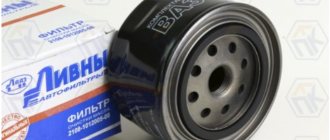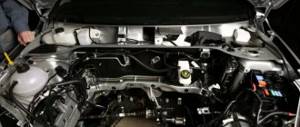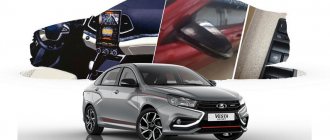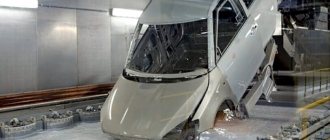↑ Vesta maintenance cost
You can find out the price of service on the AvtoVAZ website. For 4 modifications of Lada Vesta it has the same cost for different maintenance cycles. An exception to the price is the CNG model, a car that has two engines (petrol and gas).
For SW CROSS, SW, CROSS, sedan, regardless of engine size, the cost will be (thousand rubles):
- for the first maintenance – 5.4;
- for the second – 7.5;
- for the third – 5.4;
- for the fourth – 7.5;
- for 5 – 5.4;
- for 6 – 14.6.
CNG maintenance costs (thousand rubles):
- at the first maintenance – 10.8;
- the second – 12.8;
- third – 10.8;
- fourth – 12.8;
- fifth – 10.8;
- sixth – 20, 361,
Manufacturing defects are corrected free of charge, such as a windshield scratched by windshield wipers. All other costs caused by the operation of the car, for example, adding brake fluid, replacing brake pads, are paid by the car owner.
↑ Decoding of Vesta maintenance
Maintenance and repair of the Lada Vesta is necessary to maintain the operational characteristics of the car in working condition in order to avoid emergency situations.
Attention! Maintenance involves carrying out routine (mandatory) and diagnostic (control and testing) work with the replacement of spare parts and consumables that comply with the regulations.
The warranty period for Lada Vesta is 6 years or 100,000 km (either age or mileage). During this period, the machine will go through a full cycle of warranty service, during which defects caused by the manufacturer will be eliminated. In addition, any detected faults caused by the operation of the vehicle will be repaired.
The overhaul period is 1 year or mileage 15,000 km. For this period, a service book is issued, where notes are made about identified defects, breakdowns, and failures.
Starting from 105,000 km or Vesta’s age of 7 years, maintenance repeats the entire previous cycle at the expense of the car owner.
What problems are most often identified on Lada Vesta?
Corrosion of Lada Vesta parts After a run of 15,000 km, problems from this list are often identified:
- scratches on the glass (the warranty applies only if they appeared due to the operation of standard equipment);
- play in the lower ball joints;
- rubbing of the cooling system pipes;
- failure of the heated windshield;
- knocking of rear stabilizer struts;
- problems with the multimedia system;
- corrosion and burnout of the resonator body.
↑ What is zero maintenance
The inspection frequency for all Lada models, except Niva, is 12 months or 15,000 km. If the car has covered this distance before the year has expired, then maintenance should be done without waiting.
New cars with 8 valves, such as Lada Granta, Lada Kalina, Niva, are entitled to after-sales, zero maintenance when the car has been run in: 2500-3000 km. It is recommended by the manufacturer, but is not mandatory. This includes oil changes, oil filter changes, valve adjustments, and general inspection and testing. Maintenance 0 is not provided for engines on the Lada Vesta, which is reflected in the service book. But carrying out such maintenance will be advisable.
In addition to the mandatory oil and filter changes at 0, maintenance for Lada Vesta includes a series of checks:
- engine operation;
- clutch;
- gearboxes;
- pendants;
- power steering;
- brake lights;
- hand brake;
- sound signal.
In addition, the tightness of the oil tank, brake and cooling systems is checked. Lighting lamps, headlights, and alternator belts are subject to visual inspection. Wheel alignment is controlled. Determined defects are corrected in a warranty workshop.
↑ First maintenance, 15,000 km
The first maintenance after 15,000 km of mileage or 1 year of operation after purchase is carried out in certified centers that have an agreement with official dealers. From this moment on, all work performed is noted in the service book. It contains the necessary list of such works. The car owner needs to check their volume and quality in a timely manner.
Attention! Provided the zero maintenance cycle is completed, there will be fewer problems with maintenance-1.
The required scope of work during the initial inspection includes:
- changing the oil and filter, cabin air filter, drive belt;
- checking the tightness and level in the cooling system and fuel system;
- condition of brake pads, steering, front and rear suspension;
- operation of the generator, windshield wiper, heated seats, heated rear window, climate control system;
- checking the health of the battery (amount of electrolyte and charge density);
- serviceability of electric windows, mirrors, door locks
- drainage system.
Thus, all major vehicle systems are subject to diagnostics:
- steering;
- chassis;
- brake system;
- transmission;
- accumulator battery;
- electrical equipment;
- tightness of hoses and connections;
- locks.
The car body is checked for corrosion and chips. In operating mode, the engine and gearbox are listened to to determine uncharacteristic noises and knocks.
Detected deviations are eliminated with a corresponding note in the service book.
List of works during maintenance 1 (15,000 km or 1 year)
- Changing the engine oil. The oil filling volume in an engine equipped with a manual transmission is 4.4 liters, and in an engine with an AMT it is supposed to be filled in 3.2 liters. It is recommended to use ROSNEFT Maximum 5W-40 motor oil, catalog number 4 l. canisters - 4291, and price - 900 rubles . There is a more expensive option - MOBIL 3000 5W40 engine oil, which has a catalog number - 150013 (4 liter canister), but the price is already 1,540 rubles.
- Replacing the oil filter. The catalog number is 21050101200500, and the price is approximately 200 rubles .
Checks during maintenance 1 and all subsequent ones:
- crankcase ventilation system;
- hoses and connections of the cooling system;
- coolant;
- exhaust system;
- fuel lines and connections;
- covers for joints of different angular velocities;
- checking the technical condition of front suspension parts;
- checking the technical condition of rear suspension parts;
- tightening the threaded connections securing the chassis to the body;
- condition of tires and air pressure in them;
- wheel alignment angles;
- steering gear;
- checking the free play (play) of the steering wheel;
- hydraulic brake pipelines and their connections;
- pads, discs and drums of wheel brake mechanisms;
- vacuum booster;
- parking brake;
- brake fluid;
- checking the drive belt;
- checking the timing belt;
- accumulator battery;
- spark plug;
- headlight adjustment;
- locks, hinges, hood latch, lubrication of body fittings;
- cleaning drainage holes;
↑ Second maintenance of Lada Vesta, mileage 30,000 km
The second maintenance takes place the following year or after another 15,000 km. It includes all the regulations of the first and additionally several operations.
The list of routine maintenance includes replacing three filters (air, oil, fuel) and engine oil, indicating its brand in the engine compartment. Spark plugs are changed. The mechanisms for opening and closing doors, fuel tank, hood, and trunk are lubricated. The drainage system is cleaned.
After 30,000 km or 2 years of operation with less mileage, a larger volume of diagnostic work is required than with TO-1.
The car body is checked. Identified cracks, chipped paintwork, peeling of mastic from the bottom and wheel arches must be cleaned and touched up. Malfunctions of hood and door locks are adjusted.
The functionality of ball joints is diagnosed: hinges, bushings, protective caps, covers, transmission control drive cables, wheel control. The steering is checked for play and power steering functionality.
The brake system controls:
- system tightness;
- brake fluid level;
- condition of brake pads and discs;
- operation of the brakes while moving and when stopping.
The tire pressure and condition of the tires and rims are checked.
Diagnosis of the generator consists of checking the belt tension and its performance.
The level of coolant, the operation of lighting fixtures in the cabin, the electronic system, the condition of the battery, wires and fasteners are determined.
Identified defects must be eliminated.
Maintenance regulations for Lada Vesta
LADA Vesta (Lada Vesta) is the flagship line of subcompact (according to the classification adopted in Europe B+) class cars produced by AvtoVAZ JSC starting in the fall of 2020, more precisely on September 25. In terms of sales volumes, this model in Russia is second only to its sister LADA Granta (currently the first generation after a planned update). This fact determines the demand for this type of service as regulated technical maintenance (hereinafter referred to as maintenance) of LADA Vesta. It is predetermined by regulations developed by the Russian automaker specifically for its flagship model.
In Kazan, the technician offers such a relevant and in-demand type of work as Lada Vesta maintenance . Moreover, the conversation is not only about scheduled maintenance, but also about its varieties such as seasonal and extraordinary.
Regarding seasonal maintenance, we recommend contacting us twice a year (once in the fall and a second time in the spring, in order to prepare for vehicle operation in changing natural conditions and road conditions). Extraordinary maintenance is carried out at the request of the owner, for example, at a reduced interval, based on current operating conditions or upon the appearance of signs of breakdowns, the cause of which must be identified and eliminated. Such features leave an imprint on the provision of services and the specifics of their provision.
Speaking about the specifics, we note that we carry out all the work taking into account not only the fact that the car has front-wheel drive, front transverse engine placement, but also a number of other parameters. Among them are the most important ones that we take into account in our work:
- body type, it is load-bearing all-metal, but of two varieties, which determines the features of the services, the first is a four-door LADA Vesta sedan, the second is a five-door station wagon LADA Vesta SW;
- modification, we service both the basic versions of the sedan and station wagon, as well as the off-road version of the LADA Vesta SW Cross station wagon, such modifications of the sedan as the sports LADA Vesta Sport, the off-road LADA Vesta Cross, the dual-fuel LADA Vesta CNG, we are waiting for the owners of all of the listed modifications in our car service center for maintenance , and if necessary, then repairs;
- features of the LADA B platform, which affects the characteristics of servicing the chassis of the model by our craftsmen, including independent front suspension (MacPherson struts installed) and semi-independent rear suspension (torsion beam installed);
- the type of engine used, they are all in-line, gasoline, naturally aspirated, all conditions have been created, in particular, it has its own engine center, where all engines installed on the flagship model, including domestic ones, are serviced and, as needed, repaired (including possible overhauls) VAZ-21129, VAZ 21127, French H4Mk;
- specifics and design features of the transmission, we service mechanical five-speed gearboxes installed on this model, including domestic VAZ-21807 and French JH3 514 (found on cars of the first years of production), JR5, Jatco JF015E variator and five-speed robot VAZ 21827, with an electromechanical actuator ZF ;
- nuances of hydraulic brake drive, mechanical manual (parking, also known as handbrake) brake, disc brake mechanisms on the front wheels and drum brakes installed on the rear wheels.
In addition to the designated technical criteria, in our work during the maintenance of LADA Vesta, we take into account the current configuration of the vehicle and its equipment. The difference in the provision of services is small, but differences still exist.
During maintenance of the Lada Vesta, we provide a wide range of related services, which we will describe below.
Additional services
Maintenance of LADA Vesta involves carrying out such a fundamental type of operation as diagnostics. During its implementation, not only the current, actual technical condition of the sedan or station wagon, the degree of wear of certain parts included in the components and assemblies, but also probable breakdowns are determined. Eliminating them determines the relevance of this type of operation such as Lada Vesta repair. We offer repair work of any degree of complexity and volume in our car service center, including major repairs of the engines discussed above in our engine center .
Recognizing the fact that carrying out maintenance involves replacing certain components of some systems and the fluids and filters used in them, we also offer such a type of service as the sale of Lada Vesta spare parts. They are also in demand when carrying out repair work according to their need and relevance. In order to implement this task, a car shop was organized in our technical center. It contains a rich assortment of components (both original and non-original), the same fluids and consumables, accessories that are in demand when performing maintenance, and if necessary, repairing LADA Vesta. We invite you to make a purchase from us and appreciate all its advantages, including:
- quality guarantee, it makes no sense for us to sell low-quality Lada Vesta spare parts and then install them ourselves, which invariably leads to a decrease in the quality of services;
- ease of use (we offer assistance in choosing, you can use the catalog, make a choice by VIN code or, based on the recommendations of our experienced and qualified craftsmen, use made-to-order delivery);
- saving time and money, there is no point in traveling around Kazan in search of the necessary parts, everything is in place, Lada Vesta owners can take advantage of loyalty programs, and promotional offers are offered periodically.
Among other related services offered by our technical center, we note services in the field of technical inspection and car insurance.
The inspection of Lada Vesta is carried out strictly officially. There is a license, valid, issued, as expected, by RSA (the full name of this organization authorized for such actions is the Russian Union of Auto Insurers). Our accreditation area is M1 (this is the category of passenger vehicles). Services are provided in a technical inspection point equipped in accordance with all applicable rules and regulations (often the abbreviated name, the term PTO, appears in documents and oral speech). All work is carried out by technical experts authorized for such actions, having the appropriate permits and permits.
Insurance services, including automobile insurance, are provided by several insurance companies, both regional, republican and federal, which have become partners of our technical center and opened their representative offices there. That is why, by contacting us, the owner of a Lada Vesta can take out compulsory motor liability insurance , other policies of not only compulsory, but also voluntary car insurance, and not only car insurance, but also in other areas.
In other words and to summarize the above. By contacting us directly regarding technical maintenance, the owner of a Lada Vesta can take advantage of a wide range of services, including repairs, technical inspection, sale of spare parts and insurance, including automobile insurance. The second question: “When to contact us?” We'll talk about this later.
You can undergo a technical inspection and issue an MTPL policy every day.
st. Gvardeiskaya, 53, building 2
Sign up for repairs
Frequency of maintenance Lada Vesta
We raised a prosaic question and many owners of a sedan or station wagon, including modifications of the Lada Vesta, know the answer to it, it is also indicated in the Operation Manual, service book and maintenance regulations. When it comes to scheduled maintenance, we use the term service interval. Moreover, it can be either standard or shortened, depending on operating conditions.
If the conditions for using the car are not critical, then the frequency of Lada Vesta maintenance is quite traditional and typical not only for most models of the Russian automaker, but also for the global auto industry as a whole. Two criteria are used and compared. The first criterion is the number of kilometers traveled since the last maintenance in thousands. Under standard operating conditions, the service interval is 15 (fifteen) thousand kilometers. The second criterion is the operating time of the vehicle since the previous maintenance of the LADA Vesta. It is measured either in months, which is often the case, or in years. As a rule, they indicate such a defining criterion as 12 (twelve) months, also known as a calendar year.
Therefore, it is necessary to compare what will happen earlier, either 12 months will pass, or a sedan or station wagon will be able to travel more than 15 thousand kilometers in a shorter period of time (which often happens during intensive use). Keep in mind that if the operating conditions are very difficult, we recommend reducing the indicated maintenance intervals, perhaps by half. In other words, according to the first criterion, up to six months (6 (six calendar months)), according to the second, up to 7.5 (seven and a half) thousand kilometers traveled. There is an exception to this rule regarding the frequency of scheduled maintenance. It can be applied to new cars without mileage. During the so-called break-in period, we recommend carrying out the so-called zero maintenance of the LADA Vesta (TO 0), after the first 2.5 (two and a half) thousand kilometers. You will spend a little, but given the level of assembly and our experience in practical maintenance of this model of AvtoVAZ JSC, and not only this one, we recommend doing this. It is necessary to check, tighten fastenings and evaluate the operation of certain systems.
We think we have sorted out the frequency of scheduled maintenance for the LADA Vesta. Now let's talk briefly about other types of services. There is such a thing as seasonal maintenance. Its frequency has already been noted above, let us remind you - twice a year, choose free time in spring and autumn. Let us note two important facts. Seasonal maintenance, unlike scheduled maintenance, is recommended; you can adhere to it or not, the decision is up to the car owner. Based on the experience of practical maintenance of LADA Vesta, we still recommend sticking to it. Fact two. One of the two seasonal maintenance can be combined with scheduled maintenance, and if necessary, with a technical inspection, which is very useful and very convenient. Yes, the costs will be a little higher and it will also take more time, but in total it’s better than contacting us three times for the stated reasons.
We have already talked about unscheduled maintenance. Let us just note that one rule applies here. Signs of car breakdowns must be responded to immediately, even the most insignificant ones. If you ignore this and put it on the back burner, then a so-called “penny” breakdown can result in a very expensive repair, for example, a major overhaul of the Lada Vesta engine. Therefore, as soon as you realize that there is something wrong with the car, contact us; at a minimum, you need diagnostics. And we will carry out all other work by agreement with you.
Specifics of Lada Vesta maintenance
We carry out maintenance of LADA Vesta in three basic areas, so to speak, categories of work. Let's focus our attention on them. This:
- diagnostics, a fundamental type of service, it all begins with it, you need to assess the technical condition of a station wagon or sedan (regardless of the modification), identify a malfunction, establish the degree of wear of certain components, check the factory parameters and settings;
- replacement of components, both planned (either based on the service interval, or taking into account the current condition, for example, the degree of wear), and unscheduled, extraordinary (based on the detection of faults);
- service work, a wide range of works closely related to the maintenance of the subcompact flagship model under consideration, maintaining its systems, as well as their components, in working, serviceable condition, ensuring their operation at factory values.
Now about each of the parameters in more detail. Let's start with diagnosing the LADA Vesta. In our technical center, it is carried out comprehensively, which involves the use of a set of diagnostic techniques. Among other things, we note the following:
- visual inspection, so to speak, “by eye” and with the help of a flashlight, including on a lift of parts, components and assemblies available for visual inspection, based on the professional attitude, experience and high qualifications of our craftsmen;
- computer, involves the use of a scanner connected to the engine ECU, with the help of which the installed error codes are first read and then decrypted;
- instrumental, based on the use of professional equipment intended for measuring the relevant parameters, as well as the corresponding tools and instruments, we have all this in stock;
- bench test , we pay the closest attention to this type of inspection, it is based on the use of special stands, so we check the brake system using a brake stand, to assess the condition of the LADA Vesta chassis and a number of interconnected systems, we use a vibration stand, and when necessary, a backlash detector, there are a number of other stands;
- other methods for assessing the current technical condition of LADA Vesta, including the road method, “hearing” testing, “rolling”, and many other testing methods.
Take into account the fact that, based on the results of the diagnostics performed, service operations are often in demand, closely related to the maintenance of certain systems, replacement based on the degree of wear of individual parts. For example, our specialists replace Lada Vesta brake pads , and sometimes Lada Vesta repairs are also needed.
What is meant by the word replacement? This is a set of operations associated with the need to change fluids, filters and parts that are classified as consumables and are subject to wear. It has already been noted that replacement can be planned, determined by the vehicle’s operating time or mileage traveled, according to the actual condition (based on the degree of wear, absence or presence of traces of mechanical damage) or unscheduled (as breakdowns are detected). It is difficult to determine what will be needed for an unscheduled replacement; any system can break down. But for a planned replacement, the owner of a LADA Vesta will need:
- motor oil , depending on which engine is installed (approximately, VAZ 21129 with a stamped crankcase - 3.20-3.50 liters, with a cast crankcase - 4.40 l, H4Mk - 4.30 l, VAZ 21179 - 3.50 l);
- coolant, also depending on the engine (approximately, VAZ 21129 - 6.40 l, H4Mk - 7.00 l, VAZ 21179 - 7.00 l);
- transmission fluid (oil) depending on which gearbox is installed (VAZ 21807 - 2.20 l, JH3 514 - 3.50 l, JR5 - 2.30 l, VAZ 21827 - 2.25 l, JATCO JF015E - 7 .20 (full, partial 4.00 l));
- brake fluid in a volume of 0.559 l, for versions with VAZ 21827 - 0.517 l;
- windshield washer fluid (windshield washer reservoir capacity 4.70 l);
- freon in the air conditioning system (R134 – 0.475 l);
- filters, including oil, low pressure (only for dual-fuel Vesta CNG), a pair of air (one in the cabin, the other for the engine), fuel;
- spark plugs (changed as scheduled);
- brake discs (front, although they can be re-grooved, depending on condition) and pads;
- belts of attached additional equipment (auxiliary units), regardless of the engine, timing belt Lada Vesta on domestic engines VAZ 21129 and VAZ 21179).
Other parts are often in demand, such as fuses, light bulbs in external and internal lighting devices, boots, seals, silent blocks, seals, tubes, hoses, fasteners and a number of other spare parts. During the service, be prepared to spend a certain amount of money beyond what is provided for service fees and scheduled replacements.
Service operations are a large list of diverse works. We won’t talk about them all; we’ll just point out the main ones. These include cleaning systems from contamination, adding fluids, lubricating individual components, adjusting the operation of systems (head optics, tire pressure, adjusting valve temperature clearances (for the H4Mk, it does not have hydraulic compensators)) and many others.
Now let’s briefly talk about the regulatory work carried out during certain maintenance, and let’s start with TO0.
Zero maintenance Lada Vesta
So, zero maintenance during the car break-in. It is carried out, as already said, after the first 2500 (two and a half thousand) kilometers traveled. During its execution, diagnostics of many systems is carried out, among them we note the following:
- motor (checks for error codes, extraneous noise, current degree of tightening of supports, tightness of lubrication and cooling systems (condition of oil seals and various seals), level of liquids in them);
- transmission (including joints that provide wheel drive, gearbox, performance is also checked for the presence of extraneous sounds during operation);
- chassis (installation angles (talking about wheels), general condition of the suspension (both front and rear));
- steering (you need to evaluate the serviceability and functionality of the electric power steering);
- brake system (current fluid level, degree of tightness of the system as a whole, general condition of pipes and hoses, functioning of the brake signal, handbrake, degree of efficiency of the brakes, booster (vacuum));
- electrical equipment (attention is paid to the generator, as well as its drive, the wiring, light alarm, sound signal, external and internal lighting bulbs, electric headlight corrector are checked).
If we talk about the second direction of maintenance - replacement, we note that during zero maintenance, the engine oil is changed . The oil filter is also replaced at the same time. Although this is not necessary, it is advisable.
But the list of service work during zero maintenance can sometimes be quite impressive, it all depends on the current condition of the car. In this case, it is more appropriate to talk about build quality. Wheel alignment angles, headlight operation, tire pressure, and parking brake . A lot has to be tightened up and adjusted based on the diagnostic results and based on our own experience. There are, as they say, systemic shortcomings. Don’t worry, we’ll do everything right, the “swallow” will work like a Swiss watch, regardless of where it is assembled, in Tolyatti, Izhevsk or Argun (if necessary, we are ready to work with representatives of the Kazakh, Ust-Kamenogorsk assembly).
First maintenance
TO1 is already required after one year has passed from the date of purchase, or if the mark on the speedometer reaches 15 thousand kilometers traveled. The technique is still the same. First diagnostics, then replacement and service operations.
According to diagnostics. During TO1 on LADA Vesta, our specialists always check such systems as:
- chassis (body, for traces of corrosion, peeling of mastic, damage to the paint layer, operability of door locks (four for the sedan and five for the station wagon) and hood, suspension (rear and front), condition of tires (including measuring their pressure) and wheel rims , threaded connections providing fastening of the chassis directly to the body);
- steering (the total play is assessed, the current condition of the installed steering rods, their hinges and boots (protective caps), steering gear covers, electric power steering is checked);
- cooling (degree of tightness, level and condition of coolant);
- brake (brake fluid level, overall condition of the clutch and brake drive, their functioning (we are talking about both parking and working systems), level of wear of brake discs and pads (front));
- engine, special attention is paid to the belt that drives attachments (including the generator), the condition of the belt and the degree of tension are assessed, and it is checked whether non-functional knocks and noises occur during engine operation;
- electrical equipment (checked: wiring, its condition, reliability of wire connections and their fastening, functionality of the generator, lighting, both sound and light alarms, electronic systems and equipment used, instrument panel, battery (including checking electrolyte density), operation of head optics (including standards for the boundaries of light beams));
- transmission (the following are checked: the wheel drive, the condition of the ball pins, the gearbox, depending on its type and design, for example, on versions with mechanics, it is necessary to evaluate the condition of the ends of the drive cables and their protective covers, the level of oil or fluid in the box).
Let us note in more detail that when checking the condition of the front and rear suspension, the condition (degree of wear, presence or absence of traces of mechanical damage) of such components as hinges (both rubber-metal and rubber), cushions, bushings is assessed. Great attention is paid to determining the degree of tightness of all components and assemblies, their seals, tubes, hoses and fastenings at connection points. If leaks are detected, then our specialists successfully cope with this bad phenomenon. The manufacturer also recommends checking the presence of labels in the interior and their correct placement.
It is advisable to perform such work as checking:
- degree of timing belt tension on versions equipped with VAZ 21129 and VAZ 21179 engines;
- exhaust gas removal system, its degree of tightness, fastenings of elements, the same muffler;
- fuel system , degree of tightness of its hoses and pipes;
- windshield wipers and windshield washers, their performance, the level of flowing liquid in the windshield washer reservoir, the degree of wear of the windshield wiper blades;
- serviceability, if any, of power windows (electric, including their drive), systems that provide heated glass (rear), as well as seats;
- air conditioner and its operation.
Regarding replacement. The engine oil must be changed. There is a need to replace several filters. First of all, the oil filter is changed. What needs to be replaced, let's stick to the Russian automaker's terminology, is the heater filter element (in simple human language, it's a cabin filter). And on dual-fuel versions of LADA Vesta CNG, an additional scheduled replacement of the low-pressure filter is carried out.
The list of service operations for the first maintenance is determined by the results of the diagnostics performed. Particular attention to the level and condition of fluids, proper operation of electrical equipment and brakes. It is imperative to clean the drainage holes located in the doors and thresholds. It is advisable to lubricate both door stops and hinges.
Subsequent maintenance
During the second maintenance of LADA Vesta, diagnostics are performed according to the same algorithm and points as during the first maintenance; we will not duplicate them. Engine oil, as well as oil and cabin filters , are replaced during any scheduled maintenance. We will not repeat this information, just remember.
Therefore, we will only note the features of a particular service, taking into account its frequency for such a category of services provided as replacement. After every 30 (thirty) thousand kilometers or 24 (twenty-four) months of operation, in fact, at every even maintenance, to make it easier to navigate, the air filter , or rather its filter element, spark plugs . Among the service operations performed at the specified intervals are lubrication, in addition to door stops and hinges, hinges and springs used in the fuel tank flap, and keyholes of both trunk and door locks. The clamps, as well as the battery terminals, are cleaned and lubricated, and the reliability of their fastening is simultaneously assessed. We also recommend checking and balancing the wheels as necessary.
Price list for spare parts from 10.26.2020
Watch on the website Online
During every third maintenance, and this is 36 (thirty-six) months of operation or 45 (forty-five) thousand kilometers on the speedometer, you need to replace the brake fluid , plus the same work as during TO1. Although regarding the brake fluid, you need to understand what kind of fluid is filled. Currently, the Russian automaker indicates the need for replacement only after five years of operation or five years after the previous replacement, that is, at TO6; by the way, the coolant .
The fourth maintenance is the first plus the second maintenance. The fifth service completely repeats the first. the transmission oil every 75 (seventy-five) thousand in the VAZ 21827 robot (and in general you need to monitor the lubricant level, the oil seals in this box leak), in the VAZ 21807 mechanics (together with the filter ). Since we're talking about it. French manual gearboxes are maintenance-free, but from experience in practical operation and maintenance, we again recommend changing the oil in JH3 and JR5 every 60 (sixty) thousand, using Elf or Total oil, they are native to these boxes.
But the JATCO JF015E variator is a different story. Again from a series of recommended services. Optimally, it is advisable to change the transmission fluid in this continuously variable box every 40 thousand, along with coarse and fine filters, an O-ring and a pan gasket.
Next is the sixth maintenance (this is six years of operation or 90 thousand mileage). It was noted that the manufacturer indicates changing the brake and coolant fluids during this period. You also need to spend money on a belt of auxiliary units along with a tension pulley. It is changed by our masters according to plan. One important point. The VAZ 21129 and VAZ 21179 engines with a timing belt drive, this has already been pointed out. According to the regulations, the timing belt of the Lada Vesta is changed every 180 thousand (this is TO 12) along with the guide and tension roller. But if the timing belt cannot withstand such a period of operation, then its breakage can lead to bending of the valves (if the pistons are ordinary, they can also install plug-in ones with counterbores, they are installed in 2020). Therefore, the timing belt must be monitored and replacement may be required even earlier. Subsequent maintenance completely repeats the previous ones.
Let's note a few points, First. The N4Mk engine, and this index indicates that this is a French-Japanese engine, but assembled in Togliatti, and is not equipped with hydraulic compensators. That is why it is necessary to adjust the thermal clearances after every 100 (one hundred thousand) mileage by selecting pushers. Second. The fuel filter also needs to be replaced periodically ; the frequency of replacement depends on the quality of the fuel and what kind of filter is installed. For more detailed information on this issue, please contact our specialists.
If you need maintenance (scheduled, seasonal, extraordinary) for LADA Vesta in Kazan - do not waste precious time and your money - contact our technical service. From us you can get professional advice on the maintenance and operation of a station wagon or sedan, taking into account their modifications, if necessary, carry out repairs, carry out technical inspections, purchase spare parts , issue compulsory motor liability insurance or another insurance policy for the Lada Vesta. We wait! We will be glad to see! We will definitely help!
Our contacts
st. Gvardeiskaya, 53, building 2
Sign up for repairs
MAINTENANCE REGULATIONS FOR LADA VESTA
| Job title | Mileage thousand km | ||||||||||
| 15000 | 30000 | 45000 | 60000 | 75000 | 90000 | 105000 | 120000 | 135000 | 150000 | 165000 | |
| Time (months) | |||||||||||
| 12 | 24 | 36 | 48 | 60 | 72 | 84 | 96 | 108 | 120 | 132 | |
| Engine | |||||||||||
| Tightness of cooling systems | P | P | P | P | P | P | P | P | P | P | P |
| Condition of hoses, tubes and connections | P | P | P | P | P | P | P | P | P | P | P |
| No non-functional noise and vibration in the engine | P | P | P | P | P | P | P | P | P | P | P |
| Condition and tension of the auxiliary drive belt (generator) | P | P | P | P | P | P | P | P | P | P | P |
| Generator performance | P | P | P | P | P | P | P | P | P | P | P |
| Heater | P | P | P | P | P | P | P | P | P | P | P |
| Tightness of seals of components and assemblies | P | P | P | P | P | P | P | P | P | P | P |
| Exhaust system tightness | P | P | P | P | P | P | P | P | P | P | P |
| Coolant level | P | P | P | P | P | P | P | P | P | P | P |
| Fuel tank hatch | P | P | P | P | P | P | P | P | P | P | P |
| Replace the oil filter and oil in the engine crankcase | Z | Z | Z | Z | Z | Z | Z | Z | Z | Z | Z |
| Check the tightness of the mounting units | Z | Z | Z | Z | Z | Z | Z | Z | Z | Z | Z |
| Check the tightness of the mounting components and parts of the chassis and engine | Z | Z | Z | Z | Z | Z | Z | Z | Z | Z | Z |
| Replace the heater filter element | Z | Z | Z | Z | Z | ||||||
| Replace the air filter element | Z | Z | Z | Z | Z | ||||||
| Replace spark plugs | Z | Z | Z | Z | Z | ||||||
| Accessory belt (generator) with tension roller | Z | Z | |||||||||
| Replace coolant | Z | ||||||||||
| Lubricate the hinges and springs of the fuel tank hatch | R | R | R | R | R | ||||||
| Transmission | |||||||||||
| Power supply and hydraulic clutch | P | P | P | P | P | P | P | P | P | P | P |
| Condition of hoses, tubes and connections | P | P | P | P | P | P | P | P | P | P | P |
| Absence of non-functional noise in transmission units | P | P | P | P | P | P | P | P | P | P | P |
| Operation of the clutch and gearshift drive | P | P | P | P | P | P | P | P | P | P | P |
| Transmission oil level | P | P | P | P | P | P | P | P | P | P | P |
| Chassis | |||||||||||
| Condition of front and rear suspension elements | P | P | P | P | P | P | P | P | P | P | P |
| Rubber and rubber-metal hinges, bushings and cushions | P | P | P | P | P | P | P | P | P | P | P |
| Condition of steering rod joints and their protective caps | P | P | P | P | P | P | P | P | P | P | P |
| Steering gear protective covers | P | P | P | P | P | P | P | P | P | P | P |
| Wheel drives, ball pins | P | P | P | P | P | P | P | P | P | P | P |
| Cable ends for gear shift control drive | P | P | P | P | P | P | P | P | P | P | P |
| Condition of tires and rims | P | P | P | P | P | P | P | P | P | P | P |
| Air conditioning system performance | P | P | P | P | P | P | P | P | P | P | P |
| Body | |||||||||||
| Windshield wipers, washers, heated windows | P | P | P | P | P | P | P | P | P | P | P |
| Exterior mirrors and seat, electric windows | P | P | P | P | P | P | P | P | P | P | P |
| Electric locking of door locks, headlight range control | P | P | P | P | P | P | P | P | P | P | P |
| Operation of door locks, hood, trunk lid | P | P | P | P | P | P | P | P | P | P | P |
| Mechanism of seats, seat belts | P | P | P | P | P | P | P | P | P | P | P |
| Lubricate: rubbing areas of door opening limiters | R | R | R | R | R | ||||||
| Lubricate the keyholes of the doors and trunk lid | R | R | R | R | R | ||||||
| Device for moving and fixing the steering column | P | P | P | P | P | P | P | P | P | P | P |
| Control system | |||||||||||
| Total play in the steering. | P | P | P | P | P | P | P | P | P | P | P |
| Power steering performance | P | P | P | P | P | P | P | P | P | P | P |
| Brake system | |||||||||||
| Condition of manual brake cables | P | P | P | P | P | P | P | P | P | P | P |
| Power and hydraulic brakes | P | P | P | P | P | P | P | P | P | P | P |
| Condition of hoses, tubes and connections | P | P | P | P | P | P | P | P | P | P | P |
| Brake fluid level | P | P | P | P | P | P | P | P | P | P | P |
| Performance of the service and parking brake systems | P | P | P | P | P | P | P | P | P | P | P |
| Condition of pads, discs | P | P | P | P | P | P | P | P | P | P | P |
| Brake fluid | Z | Z | Z | ||||||||
| Protective covers and lubrication of front brake guide pins | P | P | P | P | P | P | P | P | P | P | P |
| Electrical equipment | |||||||||||
| Battery condition | P | P | P | P | P | P | P | P | P | P | P |
| Lighting, light and sound alarm | P | P | P | P | P | P | P | P | P | P | P |
| Control devices and alarms | P | P | P | P | P | P | P | P | P | P | P |
| Vehicle system states | P | P | P | P | P | P | P | P | P | P | P |
| Condition of the vehicle's electronic systems | P | P | P | P | P | P | P | P | P | P | P |
| Fault codes for vehicle electronic systems | P | P | P | P | P | P | P | P | P | P | P |
| The direction of the light beams and the intensity of the headlights. | P | P | P | P | P | P | P | P | P | P | P |
| Battery terminals and clamps and check the reliability of their fastening | R | R | R | R | R | R | R | R | R | R | R |
Maintenance of Lada Vesta cars Find out more
Lada Vesta Maintenance Regulations Find out more
↑ Third maintenance, mileage 45,000 km
TO-3 the car must pass through 45,000 km. The cycle repeats the first technical inspection.
The same amount of work is performed:
- Change of oil;
- air filter;
- cooling system inspection;
- brake system;
- wheel condition;
- pendants;
- transmissions;
- batteries;
- electrical equipment;
- drainage system.
This order is determined by the degree of wear of machine parts and mechanisms. At the same period of time or mileage, it is necessary to replace the brake fluid in the system.
List of works during maintenance 2 (30,000 km or 2 years)
- Repeat the first maintenance - changing the oil and oil filter.
- Replacing the air filter. Article - 165460509R, price - 750 rubles .
- Replacing the cabin filter. Article - 272773016R price - 730 rubles .
- Replacing spark plugs. Need 4 pcs, price is for 1 pc. — 735 rubles , article — DR15YC-1.
↑ Fourth and subsequent maintenance
At 60,000 km or 4 years of age, Vesta undergoes a fourth maintenance. It is identical in scope and tasks to the second.
In the fifth year or 75,000 km, the cycle returns to the third maintenance with the exception: instead of brake fluid, the oil in the manual or automatic transmission is changed.
Attention! The greatest amount of technical work will be done when the car has covered 90,000 km or its age reaches 6 years.
Mandatory maintenance work includes:
- replacement of all filter elements and lubricant;
- all working fluids if the 5-year replacement period has expired;
- spark plugs;
- generator belt and tension roller;
- processing of mechanisms for opening and closing doors, hood, trunk;
- cleaning drainage channels.
All systems, devices, machine mechanisms, wheels and body are subject to control checks.
Mileage 105,000 km or vehicle operation for 7 years: the scope of technical work is similar to the first maintenance. At 120,000 km - the second one, at the turn of 180,000 km, it is necessary to replace the timing belt.
↑ Replacements according to service life
The manufacturer recommends that car owners replace parts and consumables that are subject to the greatest impact every 15,000 km.
When using the machine in difficult conditions, the procedure must be carried out after 10,000 km or 7,500 km.
Unfavorable factors include:
- operating a car in a metropolis, when you have to travel short distances;
- driving in traffic jams at low speeds;
- driving on country roads when there is a lot of dust;
- moving a trailer or with a maximum load.
When you first call for service, the engine oil, oil filter, cabin air filter, and alternator drive belt will be replaced.
Replacing consumables during the second maintenance includes 6 items, of which 4 are mandatory and 3 are necessary. Their cost, replacement, installation are paid additionally.
This includes: engine oil, engine air and oil filters, spark plugs, cabin heater filter. Working fluids are added as needed and the front and rear brake pads are changed.
The third time you contact the technical service center, the following must be replaced:
- motor lubricant;
- oil filter;
- filter element of the cabin heating system.
Brake pads are replaced as needed, working fluids and freon are added.
At the fourth maintenance they change:
- engine oil;
- oil filter;
- engine air filter;
- candles;
- cabin heating filter.
Consumable fluids are added as needed and the front and rear brake pads are changed.
The fifth service cycle is identical to the third in all respects, including operational replacements.
TO-6. In this case, it is necessary to replace the components of the brake, fuel, and cooling systems: brake fluid, coolant, oil. The spark plugs, suspension belt, air and cabin filters, alternator belt and tension pulley are replaced. If necessary, freon is added to the air conditioning system and the brake pads are replaced.
All subsequent replacements coincide in cycles.
Attention! The exception is TO-12, on which the timing belt is changed.
List of works for maintenance 6 (90,000 km or 6 years)
- Repeat all the procedures prescribed by TO 1, TO 2 and TO 3 - change the engine oil and oil, air and cabin filters, as well as spark plugs and brake fluid.
- Replacing the alternator belt for cars without air conditioning . Article 8450006327, price - 800 rubles .
- Replacing the accessory drive belt for vehicles with climate control system . Article number 8450006328, belt price - 1100 rubles . If the belt tensioner roller (automatic) is worn out, then we change it too: article number - 8660001575, price - 3500 rubles .
- Replacing the coolant. The manufacturer recommends using Antifreeze Sintec LUX G12 red-orange, article number 614500, and the price is for 5 liters. canister - 460 rubles .
↑ Filling volumes
The amount of consumable fluids to be replaced depends on the type of engine, gearbox, cooling and heating system.
For motor 11189 (volume in l):
- the need for a lubrication system with a stamped sump is 3.2;
- with a cast crankcase - 4.4;
- for gearboxes 2180 and 2182 – 2.25;
- JHQ – 3.34;
- cooling and heating system requirement – 5.95;
- for a system with preheating – 9.3;
- for the hydraulic drive and brake system – 0.559;
- for the washer reservoir – 4.7;
- expansion tank - 5.75;
- air conditioner - 0.475.
For engine 21129, the difference in volumes lies in the following parameters:
- for a fuel system with a stamped crankcase - 2.9 l;
- with cast – 4.1 l;
- for expansion tank - 5.35 l.
HR16DE engine: lubrication system requires 4 liters; for cooling and heating – 7 l.
Recommended brands of engine oil are Maximum SW-40, MOBIL 3000 SW40, LADA ULTRA 5W-40.
Important! When replacing, mixing different brands of oil, coolant, brake fluid and refrigerant is not allowed.











